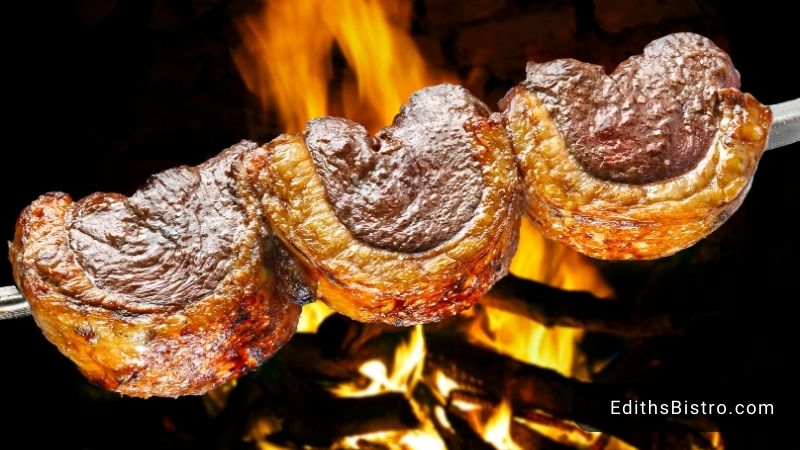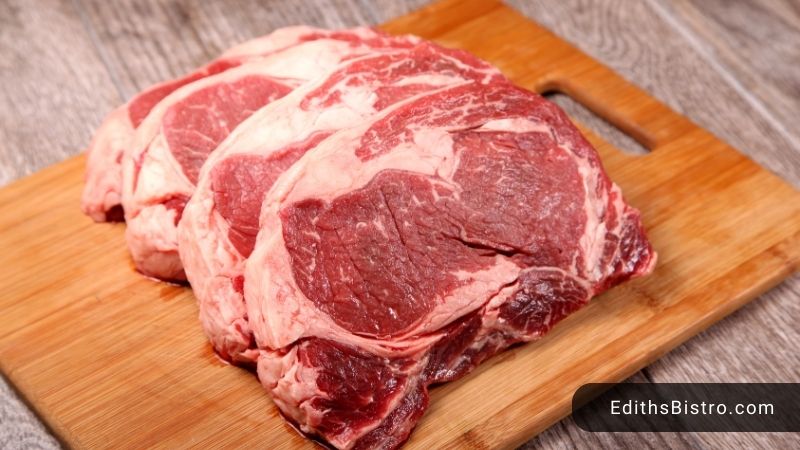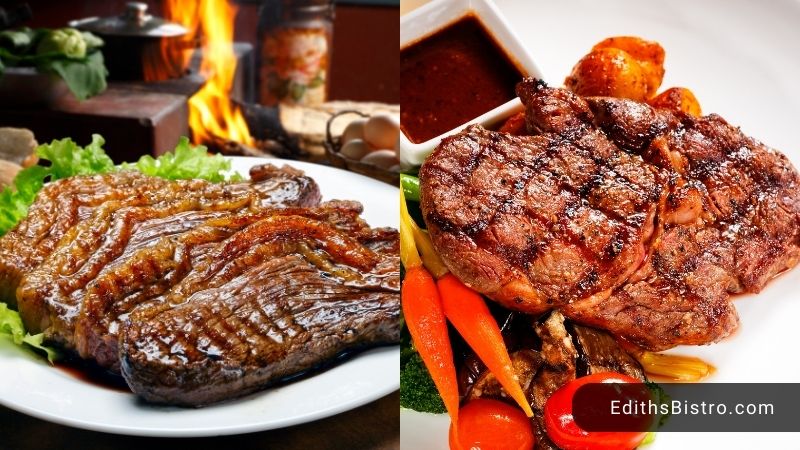Picanha and ribeye are two popular steak cuts that meat enthusiasts worldwide love. While both are delicious in their own right, they have distinct differences in flavor, texture, cooking techniques, and more.
Picanha Vs Ribeye
Key differences between Picanha and Ribeye include the cut’s location, flavor, fat content, nutritional factors, cooking methods, presentation, and price.
Picanha is known for its unique flavor and leaner meat beneath the fat cap, while ribeye is celebrated for its marbling and robust flavor throughout the meat. Picanha is more affordable than ribeye, making it a cost-effective choice. However, Picanha can be challenging to find outside of South America, while Ribeye steaks are widely available in the United States and other regions.
What is Picanha?

Picanha pronounced as “pee-KAHN-yah”, is a prized beef cut renowned in Brazilian culinary traditions. It’s also known as top sirloin cap, rump cover, rump cap, or culotte steak in the United States.
This cut originates from the primal sirloin’s upper part, specifically the sirloin’s cap. It boasts a thick layer of fat that covers one side of the meat, adding to its flavor and moisture during cooking. When prepared properly, this fat cap has a delicious, crispy exterior that enhances the overall taste of the steak.
Picanha is often cooked on skewers, following the Brazilian rodizio grilling tradition commonly seen in Brazilian barbecue restaurants. Its rich, beefy flavor and tender texture have made it a sought-after choice in Brazil and among steak enthusiasts worldwide.
Pros
- Flavorful: Picanha is known for its rich, beefy flavor, especially the cap of fat that adds a unique taste.
- Tender: When prepared correctly, Picanha can be incredibly tender. It is more tender than ribeye.
- Cost-effective: It is often more affordable than other premium cuts, offering great value for its taste.
- Versatile: Picanha can be cooked in various ways, including grilling, roasting, or even skewering for Brazilian-style barbecue.
- Higher protein content: Compared to a ribeye steak, Picanha offers a higher protein content.
Cons
- Not widely available: Picanha can be challenging in some regions, limiting accessibility.
- Fat content: While the fat cap adds flavor, it may not be suitable for leaner options.
- Less familiarity: Picanha is not as well-known as other cuts, which may deter some consumers from trying it.
What is Ribeye?

Ribeye is a popular and flavorful cut of beef known for its rich marbling and tenderness. It is primarily composed of the longissimus dorsi muscle, often called the “eye” of the ribeye.
Additionally, ribeye steaks contain the spinalis and complexus muscles. The spinalis, sometimes called the “ribeye cap”, is a well-marbled outer layer of the steak, while the complexus is a smaller muscle located at the front of the ribeye.
These steaks are known for their delicious flavor and tenderness, originating from the upper rib section, roughly between the sixth and twelfth ribs of the cattle. Their marbling of fat makes them excellent for quick, high-heat cooking methods like grilling and pan-searing. Ribeye steaks (perfect for grilling) are often considered one of the most flavorful cuts of beef available.
Pros
- Flavorful: Ribeye is renowned for its rich, beefy flavor, making it a favorite among steak enthusiasts.
- Well-Marbled: It has abundant marbling, which enhances juiciness and contributes to its delicious taste.
- Widely Available: Ribeye steaks are readily available at most butcher shops and supermarkets, making them convenient to purchase.
- Versatile: Ribeye can be prepared using various cooking methods, such as grilling, pan-searing, or broiling, offering culinary flexibility.
Cons
- Price: Ribeye steaks are more expensive than other cuts due to their popularity and high demand.
- Less Lean: Ribeye is not a lean cut, so individuals looking for lower-fat options may opt for other cuts.
Picanha vs Ribeye: 9 key differences
Both Picanha and ribeye offer delicious beef experiences, each with distinct characteristics. Here are several key differences between Picanha and ribeye steak:
| Characteristics | Picanha | Ribeye |
|---|---|---|
| Cut and location | This cut of steak comes from the top sirloin cap and includes a thick cap of fat on the top. | Ribeye steak is cut from the rib area of the cow, specifically from the longissimus dorsi muscle. |
| Flavor and Texture | Picanha offers a unique flavor due to the fat cap, which renders during cooking, infusing the meat with a rich, beefy taste. It is extremely tender. | Ribeye is known for its well-marbled interior, resulting in a juicy, tender steak with a pronounced beef flavor. It has a more consistent texture throughout. |
| Presentation | Picanha’s presentation includes the distinctive fat cap, which adds to its visual appeal. | This popular cut is recognizable for its circular shape and well-marbled interior. |
| Fat content | Most of the fat in Picanha is external, primarily in the form of the fat cap. The meat beneath the fat cap is relatively lean, making it a good balance of fat and lean meat. | Ribeye steaks are well-marbled throughout the meat, meaning small streaks of fat are distributed within the muscle. Generally, ribeye steak is higher in fat content than Picanha. |
| Nutritional factors | Picanha steaks have a richer protein content compared to ribeye steak. | Ribeye steaks come with less protein than Picanha steaks. |
| Cooking Method | Picanha is often grilled as a whole cut, with the fat cap facing up. This allows the fat to continuously baste the meat as it cooks. After grilling, it is typically sliced into thin pieces. | Ribeye can be prepared using various methods, including grilling, pan-searing, or broiling. It’s commonly served as a whole perfect steak. |
| Famous dishes | Some popular dishes featuring Picanha steak include Traditional Brazilian Churrasco and Picanha Skewers. | Ribeye steak is a versatile and highly regarded cut of beef, often used in famous dishes such as Steakhouse Ribeye, Prime Rib, and Philadelphia Cheesesteak. |
| Price | Picanha steaks are more affordable than ribeye steaks. | Ribeye steaks typically have a higher price tag, ranging from 30% to 40% more expensive than Picanha steaks. |
| Popularity | Picanha is highly popular in South America, especially in Brazil. However, it is pretty hard to find in some regions. | Ribeye is a popular cut of beef, widely favored in the United States and many global regions, resulting in its widespread availability at butcher shops and supermarkets. |
Is Picanha Better Than Ribeye?

In the battle of ribeye and Picanha, both steaks are exceptional in their own right, catering to different preferences and occasions.
Picanha shines with its Brazilian heritage, offering a unique triangular shape and a flavorful fat cap.
In contrast, ribeye is an American classic cut of meat, celebrated for its remarkable marbling and versatility in cooking methods.
The choice ultimately comes down to your taste and cooking style. Whichever you choose, savoring the flavors of these premium steaks is a culinary experience that steak enthusiasts cherish.
FAQs
Is Picanha steak good?
Yes, Picanha is a flavorful steak. It is known for its rich flavor, unique marbling, and juiciness.
Is Picanha the best steak?
Whether Picanha steak is the best steak is a matter of personal preference. Picanha stands out for its excellent balance of lean meat and a cap of fat, which contributes to its rich flavor and juiciness.
Other steaks like ribeye, filet mignon, or T-bone also have their devoted fans, each offering distinct flavors, textures, and qualities. The best steak ultimately depends on individual taste and the specific dish or cooking method.
Why is Picanha not popular in America?
Picanha isn’t as popular in America due to unfamiliarity, differing butcher practices, established culinary traditions, and the dominance of American cuts like ribeye. The grilling culture and availability also contribute, as Picanha isn’t commonly featured in American supermarkets or menus.
References:
- Wikipedia – Picanha – https://en.wikipedia.org/wiki/Picanha
- Wikipedia – Rib eye steak – https://en.wikipedia.org/wiki/Rib_eye_steak






![What To Pair With Quiche? 25+ Best Dishes [With Pictures]](https://www.edithsbistro.com/wp-content/uploads/2024/04/what-to-pair-with-quiche-160x90.jpg)
